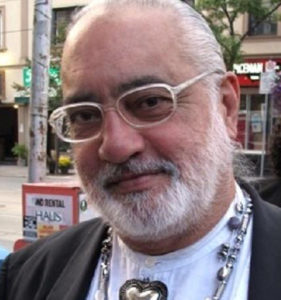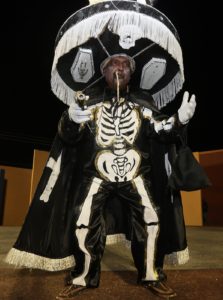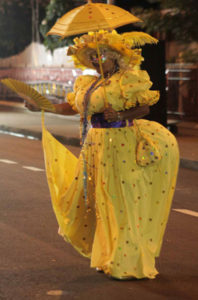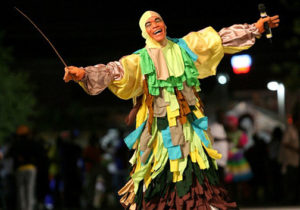(From Venice to Toronto via Trinidad and Tobago)

By Christopher Pinheiro
How did people with no formal art or theatre-training arrive at the extravagant playing-out of elaborate character costumes?
Have the Carnival-loving citizens of Trinidad and Tobago become visually literate by the very process of spectatorship and participation in “the Mas”?
Can the work of MasMan, Peter Minshall, be considered traditional or innovative? The answer is “yes” on both counts!
As the Commedia dell’Arte took street performances out of the Venetian street Carnival and put them on stage in plays, ballets and operas, and as the subjects of paintings, sculptures and films…so, too, did the traditional masquerades of T&T are often drawn upon as source material for directors, composers, choreographers, visual artists and film-makers.
With a plethora of character archetypes to draw upon, constellations of monarchs and courtiers offer vast avenues on which to promenade. That Midnight Robber, Dame Lorraine, Pierrot Grenade, Jab-Jab, Dragon…many with their own movements and, often, speeches.
The surrealism of the Fancy Sailor, the erotic tableaux of Jab Molassi and apocalyptic Dantesque Devil Bands are but a few to be re-purposed.
Most recently, “Carnival Messiah” by the late Geraldine Connor hybridized the Handel classic into kaisonic form, which was performed at the Columbus Centre in Toronto, and then toured internationally.

The Jouvay Popular Theatre Process, developed and popularized by the late Tony Hall (brother of the comedic “Sprangalang”). Trinity in Trinidad now connects the University of the West Indies at Saint-Augustine with Trinity College, University of Connecticut, which sends students on a practicum into the eco-system of the Mas Camp to dwell within the hub of Carnival costume realization. Tony Hall’s intent here is to broaden the scholarship around artist-theory in the Mas and provide apprenticeships for Design and Theatre students reading for University degrees.
The newly founded UTT (University of Trinidad and Tobago) now offering a Masters Degree in the Carnival Arts has as its Chancellor career Calypsonian, Hollis Liverpool…Calypso sobriquet, Mighty Chalkdust.
Students are required to do an attachment to either (1) a Mas Camp (2) a Pan Yard (3) a Calypso Tent…documenting their research processes and findings. Also encouraged are mixed-media, multi-sensory installations with performative vignettes. Photographs, Carnival-costume designs, video clips of performances and power-point presentations of the Mas in a variety of settings could be among the visuals.
Sound-scapes of classics from the Kaiso-Calypso-Soca-Rhapso-Chutney continuum could add to the heightened sense of “excitation”. Testimonial speeches from Monsieur Pierrot Grenade and Senor Midnight Robber, with live sounds, dancers and drums of both skin and steel, round out the entertainment factor.
The Masquerade characters of Pierrot and Harlequin can both trace their ancestry back to Venice in the 1500s, spreading all across Europe, to find favour in France at the court of Louis the fourteenth, who played the Sun King in rich costumed tableaux in the 1600s.
French settlers to Trinidad established cocoa plantations in the late 1700s and hosted lavish Masquerade Balls for which African musicians were paid to play drums, flutes and fiddles. The Africans held their own festivities in their yards.

After Emancipation the two streams flowed out together into the streets to jump up and prance their processional choreographies, concentrating on urban centres.
In the nineteen-thirties Masquerade Competitions were held in downtown Port-of-Spain. In the fifties the action moved uptown to the Grand Stand at the Queen’s Park Savannah.
In the 60s Caribana Parade and Competition began in Toronto bringing together revellers from many Caribbean islands ecstatically dancing to that year’s hits from Trinidad. A holiday weekend turned into a month of Carnival-related activities…Soca-boat cruises, buffets and banquets, Calypso tents, Steelband competitions, Kiddies Carnival celebrating the Sun and Summer. Hamilton, Barrie, Montreal and Vancouver have developed their own Community Carnivals.
London’s Notting Hill Carnival in the UK dates to the 1950s. New York’s Labour Day in Brooklyn began in the 60s. Atlanta, California and Miami are now Mas-friendly.
Singers and musicians traverse the Carnival diaspora earning kudos and cash for stalwart application to their craft.
From historical extravaganzas out of the encyclopaedia to free-form fantasies and Heromyth, the evolution of the Carnival experience is ever-changing.
Social and political commentary and protest, once the province of the Kaiso, is now to be found in visual and theatrical executions in the Mas itself.
Shadowland Theatre Inc, coming out from Toronto Island, has specialized in enviro-dramas, expressing concern for the lakes, trees, birds and other endangered

species. In conjunction with city-based VideoCabaret and the then national airline, BWIA…an artists-exchange programme, aptly titled “Island to Island” where art-makers completely immersed themselves in all aspects of the Carnival.
Internationally, Carnivals have blossomed wherever a concentration of Caribbean people is located. Germany, Switzerland, and Tokyo have joined the merry-making.
Regardless of costume, just the notion of taking to the streets in a demonstration of the solidarity of personhood is liberating. Streets are made for cars. Grandmaster Calypsonian, Lord KItchener, decrees that “the Road Made to Walk on Carnival Day”…and dance, too! Making it quite clear that we, the people, are worth more than a motor car.
Play Mas!


